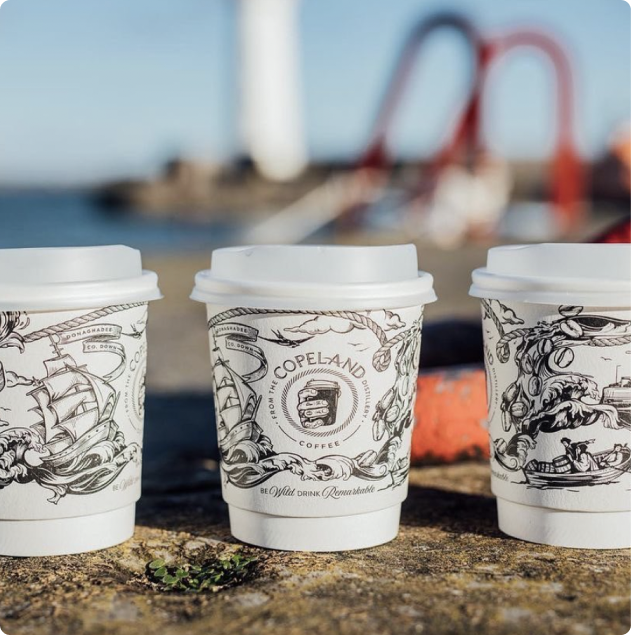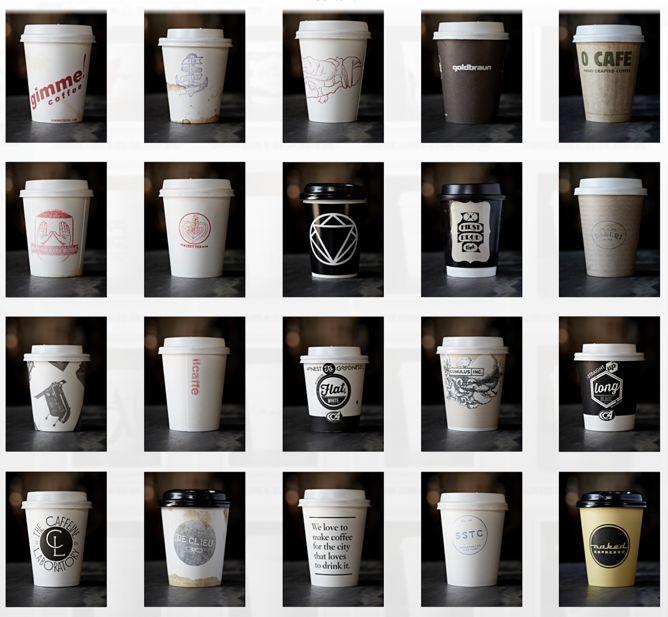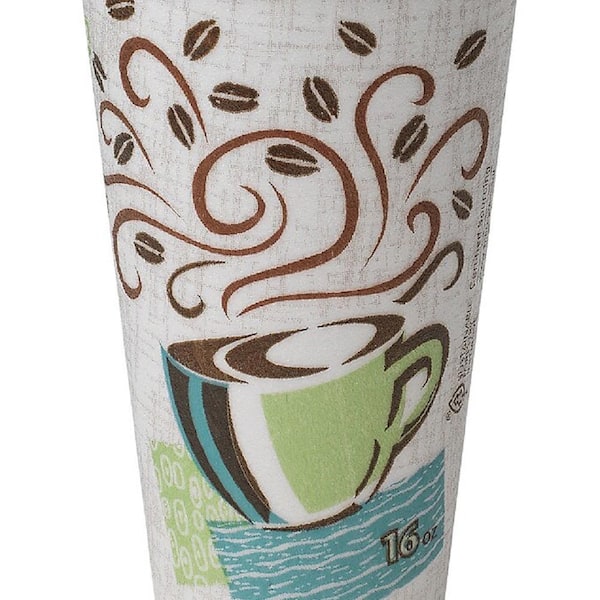What Are the Latest Trends in Disposable Coffee Cup Design?

The world of disposable coffee cup design is ever-evolving. In this section, we’ll explore the latest trends in this area, focusing on color palettes, seasonal designs, innovative shapes, and the impact of branding and social media.
Emerging Color Palettes and Patterns
Trends in disposable coffee cup design often reflect what is popular in the broader market. Bright, bold colors like vibrant greens and deep blues are becoming more common. Earth tones such as browns and beiges are also prevalent, resonating with eco-conscious consumers. Patterns are evolving too. Stripes, polka dots, and even abstract designs catch the eye. Graphic designs featuring coffee-related themes or eco-friendly messages are popular.
Incorporating diverse designs can help brands stand out. Visual appeal plays a big role in attracting customers, making strong colors and patterns vital for effective marketing.
Seasonal Designs and Customer Behavior

Seasonal themes can significantly influence customer purchase behavior. For instance, during autumn, many coffee shops launch pumpkin spice flavors, and the cups often feature warm fall colors and autumn leaves. Winter designs may include snowflakes or festive colors. According to a study, businesses that change cup designs for different seasons can increase sales by as much as 20%.
This trend not only creates excitement but also encourages limited-time purchases. Many customers enjoy the novelty of fresh designs that tie into seasons or holidays. Appealing to emotions associated with these times can inspire consumer loyalty.
The Role of Branding
Branding plays a critical role in disposable cup design. Many coffee chains, like Starbucks, use unique cup designs as a major part of their marketing strategy. A well-branded cup provides an opportunity for businesses to showcase their identity and message. A striking design can lead to visual recognition and repeated purchases.
For example, the Anthora cup, famous for its blue and white design, is considered iconic in New York. Its culturally infused branding helps in building a strong connection with local customers. A cup's design can become synonymous with the brand it represents, and strong aesthetics can often elevate customer experiences.
Innovative Shapes of Disposable Cups

The shape of disposable coffee cups is also seeing innovation. Traditional cylindrical shapes are expanding. Some brands experiment with unique geometrical structures to improve grip and user experience.
For example, the double-walled cup not only provides insulation but also creates an eye-catching silhouette. These advancements can make a cup feel more luxurious, setting a brand apart from competitors. Consumer reactions to these shapes have been positive, improving the overall enjoyment of their coffee.
Social Media’s Impact on Designs
Social media has transformed how coffee cup designs are shared and marketed. Platforms like Instagram encourage visually appealing cups, as consumers often post photos of their drinks. A standard cup might not attract as much attention as one that’s visually striking.
Brands leverage this trend by creating shareable designs. Cups with quirky slogans or beautiful patterns increase consumer engagement. Being featured on social media can create virality and drive more customers into coffee shops.
Notable Case Studies of Successful Branding
Many brands have embraced innovative disposable coffee cup designs successfully. One prominent example is Starbucks, which regularly releases limited edition holiday cups. These cups feature captivating designs that generate significant buzz each year. The excitement around these cups creates scarcity, prompting customers to buy, collect, and share their finds.
Another notable case is Dunkin’, which invested in cup design updates to attract a younger demographic. Bright colors and fun illustrations have increased their market share among millennials and Gen Z consumers. These strategies demonstrate the effectiveness of creative branding in appealing to specific audiences.
Cultural Influences on Design Trends
Cultural factors greatly influence disposable coffee cup design. Different regions often have distinct styles and preferences. For instance, in countries with rich coffee cultures, like Italy, designs may focus on elegance and tradition.
Moreover, local celebrations and traditions can inspire seasonal designs. Brands should stay aware of these nuances to connect authentically with their audience. Ignoring cultural elements may lead to designs that don’t resonate, ultimately impacting sales.
Συμπέρασμα
The world of disposable coffee cup design is fascinating and diverse. Emerging trends in color, branding, and shape are reshaping how consumers view and purchase coffee. Understanding these elements helps brands innovate and engage effectively with their target audiences.
What Materials Are Used in Eco-Friendly Disposable Coffee Cup Designs?

Sustainability is more than just a trend; it's a necessity. Today, many businesses want to reduce their impact on the environment while still providing quality products. Disposable coffee cup designs are at the forefront of this movement. So, let’s explore the materials used in eco-friendly disposable coffee cup designs.
What are the most sustainable materials used for disposable coffee cups today?
When we talk about sustainable materials, paper is the most common choice for disposable coffee cups. Χάρτινα ποτήρια are made using pulp sourced from renewable resources. Many manufacturers now use chlorine-free paper, which is better for both the environment and health.
Another option becoming popular is biodegradable plastics. Unlike traditional plastics, these materials break down naturally over time. Plant-based plastics are also emerging as a viable option. They are made from natural resources like corn or sugarcane, providing an alternative to petroleum-based plastics.
Κομποστοποιήσιμα κύπελλα are gaining ground too. These cups can be broken down into natural elements in a compost environment. The average lifespan of these cups in a composting system is around three months, greatly reducing long-term waste.
How do biodegradable options compare to traditional paper cups in terms of environmental impact?
Biodegradable cups generally have a lesser environmental impact compared to traditional paper cups. Traditional paper cups often have a plastic lining that can hinder recycling. This means they might end up in a landfill, where they can take decades to break down.
On the other hand, biodegradable options can decompose within months. Studies show that biodegradable cups can reduce landfill contributions by up to 30%. However, they still require proper disposal methods to ensure effectiveness.
Even though biodegradable options come with a slightly higher production cost—roughly 15-20% more than traditional cups—demand remains high because consumers are more aware of waste impacts. Approximately 72% of consumers are willing to pay more for eco-friendly products.
What innovations in material science improve the recyclability of coffee cups?
Innovations in material science are reshaping the landscape of disposable coffee cup design. One significant advancement is the use of water-based coatings instead of plastic linings. These coatings allow paper cups to be recycled alongside standard paper products. This means that the cups can more easily fit into existing recycling streams.
Moreover, enhanced recycling technologies are developing. High-tech facilities can process materials that were previously non-recyclable. For instance, new sorting technologies can identify and separate cups with plastic linings from those made with pure paper.
How do sustainable manufacturing processes reduce the overall environmental footprint of coffee cups?
Sustainable manufacturing processes play a vital role in minimizing environmental impact. Research indicates that eco-friendly methods can cut environmental impact by up to 30% when compared to traditional production methods.
This reduction is achieved through energy-efficient machinery, decreased resource usage, and waste management practices. For example, many manufacturers now utilize renewable energy sources like solar or wind power in their production lines.
Additionally, many factories focus on waste reduction. Any paper waste generated during production can often be recycled or repurposed for other uses.
What should businesses consider when choosing the right cup materials for their brand?
When selecting materials, businesses must weigh several factors. First, they should consider consumer preferences. Research shows that 78% of consumers prefer drinks served in sustainable packaging. Brands that align with these values typically see better sales.
Next, they must evaluate the cost. Although sustainable materials are often priced higher initially, the long-term benefits usually outweigh the drawbacks. Brands aligning with sustainability can improve their image and loyalty.
Local regulations are another critical aspect. Different regions have various rules regarding recycling and waste management. Brands should ensure their materials comply with local laws to avoid penalties and ensure efficient disposal.
How do consumers' attitudes toward eco-friendly materials affect purchasing decisions?
Consumer attitudes significantly influence the success of brands. Studies indicate that brands showing a commitment to sustainability see a direct boost in sales. A whopping 90% of consumers show a preference for eco-friendly packaging.
Millennials and Gen Z, in particular, are driving this demand. They are likely to choose brands that demonstrate eco-friendly practices. Incorporating these materials will not only meet consumer expectations but also strengthen brand loyalty.
What are common misconceptions about the recyclability of disposable coffee cups?
One common misunderstanding is that all paper cups are recyclable. Recycling rates for paper cups remain low, largely due to the plastic lining. While some cups made from uncoated paper can be recycled, those with plastic linings are often discarded.
Another misconception is that biodegradable cups don't need proper disposal methods. While they can decompose much faster than traditional options, they still require composting facilities to be effective. Without these, biodegradable cups can end up in landfills, producing the same environmental damage as their non-biodegradable counterparts.
Summary of Key Findings
| Τύπος υλικού | Περιβαλλοντικές επιπτώσεις | Cost Comparison | Προτίμηση των καταναλωτών |
|---|---|---|---|
| Χαρτί | Note: Generally recyclable if uncoated | Lower initial cost | 78% prefer |
| Biodegradable Plastics | Breaks down in months, but needs proper disposal | Higher by 15-20% | 90% prefer |
| Κομποστοποιήσιμα κύπελλα | Decomposes in 3 months under ideal conditions | Similar to biodegradable | 72% willing to pay more |
By understanding the materials and options available, we can contribute to reducing waste and improving our environmental footprint through thoughtful disposable coffee cup design.
What Are the Best Practices for Designing Custom Printed Coffee Cups?
When it comes to disposable coffee cup design, knowing the best practices can set your brand apart. Here’s a breakdown that can guide you through the steps of creating eye-catching cups that resonate with your customers.
What printing techniques yield the best results for custom coffee cup designs?
Choosing the right printing techniques can make all the difference. Flexographic printing is a popular method for coffee cup designs due to its speed and capability to print vibrant colors on large quantities. This technique is efficient for bulk orders too, making it ideal for coffee shops.
Another option is ψηφιακή εκτύπωση, which allows for more intricate designs and the flexibility to print smaller quantities. This is perfect for brands wanting to test different designs without the need for large runs. However, digital prints may not have the same durability and quality as flexographic prints on longer runs.
Then we have εκτύπωση offset, which produces high-quality images. While it requires more initial setup, it’s excellent for detailed artwork and can handle various materials. The choice of ink is critical too. Using food-safe inks ensures that the printed designs maintain color without affecting the beverage's taste.
How does graphic design impact the consumer’s perception of a brand?
Graphic design plays a pivotal role in how consumers see a brand. Research shows that a well-designed coffee cup can boost a brand's recognition. When people sip from a beautifully designed cup, they associate the quality of the cup with the quality of the coffee.
Here are some key points to consider:
- Color Psychology: Colors can evoke emotions. For instance, brown tones can create a sense of warmth while vibrant colors can signal creativity.
- Font Choices: A unique font can add personality. Clean and readable fonts communicate professionalism, while fun, playful fonts can suggest a more casual vibe.
- Imagery: High-resolution images can grab attention. They can highlight the coffee's source or even seasonal themes to keep the design fresh.
What tools can designers use to create effective mockups for coffee cup designs?
Creating mockups is essential for visualizing your design in real life. Some useful tools include:
- Adobe Illustrator: Offers extensive features for detailed vector designs, making it a go-to for many graphic designers.
- Canva: A user-friendly tool that helps in creating designs quickly, even if you have limited design experience. It offers templates specifically for coffee cups.
- 3D modeling software like Blender: For advanced designs, using 3D tools can provide a realistic view of your cup from all angles.
- Mockup generators like Placeit: These enable designers to quickly plug in their artwork and see it on a cup, streamlining the feedback process.
How can personalized coffee cup designs enhance customer loyalty?
Personalized designs resonate deeply with customers. For example, adding a name or a special message to a cup can create a unique experience that makes customers feel special. This simple touch often leads to repeat business.
Some effective personalized ideas are:
- Seasonal designs featuring customer names.
- Birthday specials where customers receive a free cup design.
- Engaging community quotes or local landmarks to generate local pride.
What are some key considerations for ensuring print quality on disposable cups?
Ensuring print quality is crucial. Here are a few key considerations:
- Επιλογή υλικού: Using high-quality paper or biodegradable options affects the overall print quality. The best disposable cups are made from pulp sourced from renewable resources.
- Testing: Always conduct print tests before finalizing a design. This can save costs by identifying potential issues early.
- Finishing: Consider protective coatings that can enhance durability and print vibrancy. Options like gloss or matte finishes can influence how the design is perceived.
How can brands utilize limited edition designs to boost engagement?
Limited editions create urgency. They can draw customers in and encourage them to purchase quickly. Collaborating with local artists for these limited designs can attract a loyal following. This approach creates excitement and encourages social media sharing.
What are effective marketing strategies for promoting custom coffee cups?
To effectively market custom coffee cups, consider the following strategies:
- Social Media Promotions: Share your designs on platforms like Instagram and TikTok. Engaging visuals can attract attention.
- Consumer Interaction: Allow customers to vote on design elements or participate in design contests. This can build community.
- Promotions and Giveaways: Use limited edition cups as prizes for contests to drive engagement.
- Highlight Sustainability: Using eco-friendly materials can attract customers who prioritize sustainability. Use it as a major selling point when marketing your cups.
Table of Printing Techniques
| Printing Technique | Περιγραφή | Ιδανικές περιπτώσεις χρήσης |
|---|---|---|
| Flexographic | Fast and efficient for large quantities | High-volume orders |
| Digital | Allows for intricate designs, small runs | Testing designs and short runs |
| Offset | High-quality images, detailed artwork | High-end designs and varied materials |
In the fast-growing coffee cup market, understanding these best practices for disposable coffee cup design can significantly enhance your brand's presence and customer loyalty.
FAQs about Disposable Coffee Cup Design
What are the latest trends in disposable coffee cup design?
A: The latest trends in disposable coffee cup design include emerging color palettes, seasonal designs, innovative shapes, and strong branding influenced by social media.
How do seasonal designs impact customer behavior?
A: Seasonal designs significantly influence customer behavior, with businesses that change designs typically seeing sales increases of up to 20%.
What materials are commonly used in eco-friendly disposable coffee cups?
A: Common materials used in eco-friendly disposable coffee cups include paper sourced from renewable resources, biodegradable plastics, and compostable options that decompose in composting environments.
How do branding strategies enhance disposable coffee cup designs?
A: Branding strategies enhance disposable coffee cup designs by creating unique visual identities that lead to increased brand recognition and customer loyalty.
What role does social media play in disposable coffee cup marketing?
A: Social media plays a crucial role in disposable coffee cup marketing by promoting visually appealing designs that encourage consumer engagement and sharing.
In this post, we explored the latest trends in disposable coffee cup design, focusing on color, branding, and customer behavior. We examined eco-friendly materials and noted the benefits of biodegradable options. Then, we discussed best practices for custom designs and how they boost brand engagement.
Ultimately, thoughtful design can attract more customers and create loyalty. By staying updated on trends and using sustainable materials, your coffee cup business can thrive. Keep these insights in mind as you move forward in your design journey.
